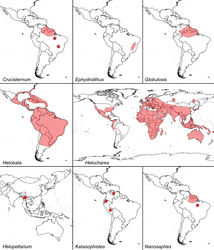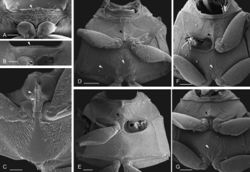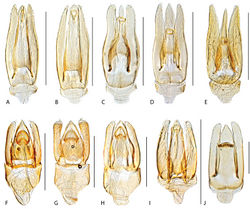Crucisternum
| Notice: | This page is derived from the original publication listed below, whose author(s) should always be credited. Further contributors may edit and improve the content of this page and, consequently, need to be credited as well (see page history). Any assessment of factual correctness requires a careful review of the original article as well as of subsequent contributions.
If you are uncertain whether your planned contribution is correct or not, we suggest that you use the associated discussion page instead of editing the page directly. This page should be cited as follows (rationale):
Citation formats to copy and paste
BibTeX: @article{Girón2021ZooKeys1045, RIS/ Endnote: TY - JOUR Wikipedia/ Citizendium: <ref name="Girón2021ZooKeys1045">{{Citation See also the citation download page at the journal. |
Ordo: Coleoptera
Familia: Hydrophilidae
Name
Crucisternum Girón & Short, 2018 – Wikispecies link – Pensoft Profile
- Crucisternum Girón & Short, 2018: 116.
Gender
Masculine.
Type species
Crucisternum ouboteri Girón & Short, 2018: 121; by original designation.
Diagnosis
Small beetles, body length 2.0–2.5 mm. Body shape elongated oval in dorsal view; moderately convex in lateral view (Fig. 29). Color orange brown to dark brown. Head trapezoid. Eyes moderate to small, projected from outline of head. Clypeus trapezoid, with anterior margin broadly and roundly emarginate. Labrum fully exposed. Mentum with lateral oblique ridges; anterior median depression marked by transverse carina (Fig. 29C). Antennae with nine antennomeres, with cupule only slightly asymmetrical and rounded. Maxillary palps moderately long, slightly longer than width of head (Fig. 29A). Elytra without sutural striae, with outer margins of elytra slightly flared; serial punctures, ground punctures and systematic punctures similar in size and degree of impression, either shallow or rather sharply marked; all punctures seemingly arranged in rows (Fig. 29A). Prosternum with well-developed median, longitudinal, laminar carina (Fig. 29C). Posterior elevation of mesoventrite with a strongly produced, anteriorly pointed transverse ridge, longitudinally carinate (Fig. 14C); anapleural sutures sinuate, separated by distance nearly 0.6 × width of anterior margin of mesepisternum. Metaventrite densely pubescent, except for median and postero-lateral glabrous patches (Fig. 29C). Protibiae with spines of anterior row long and thick; apical spurs of protibiae short and stout, almost reaching apex of protarsomere 2. Metafemora covered by hydrofuge pubescence along basal 4/5 (Fig. 29C). Metatarsomeres 2–4 gradually slightly decreasing in size; metatarsomere 5 slightly longer than 2; ventral coverage of tarsomeres composed of fine and spiniform setae. Fifth abdominal ventrite apically rounded, truncate, or slightly emarginate, without stout setae. Aedeagus trilobate (Fig. 30A–E); basal piece 0.2–0.25 × the length of parameres; median lobe with well-developed lateral basal apodemes, and acute to narrowly rounded apex; parameres nearly as long as median lobe, with outer margins usually sinuate; gonopore situated distad of midlength of median lobe.
Differential diagnosis
Although Crucisternum is generally unremarkable dorsally from other small-bodied Neotropical acidocerines, several sternal features are strikingly unique and easily separate the genus from all others. The strongly developed prosternal carina found in the genus, combined with the cruciform shape of the posterior elevation of the mesoventrite (formed by the fusion of both transverse and longitudinal ridges), is unique for this genus in the subfamily. Crucisternum is most likely to be confused in samples as a very small Chasmogenus but can also easily be distinguished from that genus by the lack of sutural striae.
Distribution
Neotropical: Brazil (Minas Gerais, Pará), French Guiana, Guyana, Suriname, Venezuela; Fig. 5.
Natural history
All species of the genus are associated with forested streams, usually along margins that contain ample detritus. A single specimen of C. ouboteri was collected at a black light trap.
Larvae
Immature stages are not known for the genus.
Taxonomic history
The genus was only recently described.
Remarks
There are seven species currently known.
Species examined
Holotypes and paratypes of all the known species were examined for this study.
Selected references
Girón and Short 2018[1]: original description of the genus and all its known species; Short et al. 2021[2]: phylogenetic placement.
Taxon Treatment
- Girón, J; Short, A; 2021: The Acidocerinae (Coleoptera, Hydrophilidae): taxonomy, classification, and catalog of species ZooKeys, 1045: 1-236. doi
Images
|
Other References
- ↑ Girón J, Short A (2018) Three new genera of acidocerine water scavenger beetles from tropical South America (Coleoptera, Hydrophilidae, Acidocerinae).ZooKeys768: 113–158. https://doi.org/10.3897/zookeys.768.24423
- ↑ 2.0 2.1 Short A, Girón J, Toussaint E (2021) Evolution and biogeography of acidocerine water scavenger beetles (Coleoptera: Hydrophilidae) shaped by Gondwanan vicariance and Cenozoic isolation of South America.Systematic Entomology46(2): 380–395. https://doi.org/10.1111/syen.12467

![Figure 2. Phylogeny of the Acidocerinae simplified from Short et al. (2021)[2], indicating the distribution, preferred habitat, and currently described number of species for each genus. For habitat, filled black circles indicate that at least some species of the genus are commonly found in this habitat; light grey circles indicate the genus has been found in this habitat, but is rare or not typical for the group; white circles indicate no species have been recorded for the genus in this habitat.](https://species-id.net/o/thumb.php?f=Zookeys-1045-001-g002.jpg&width=184)



